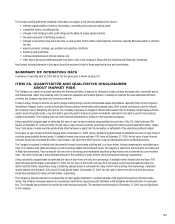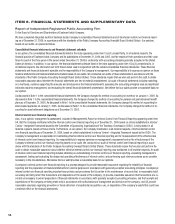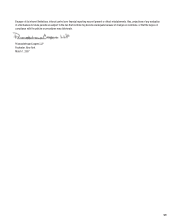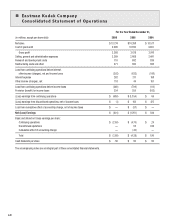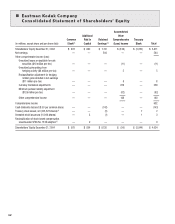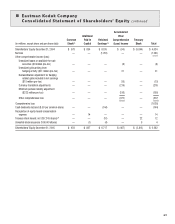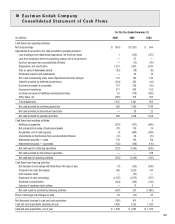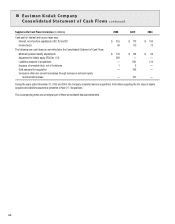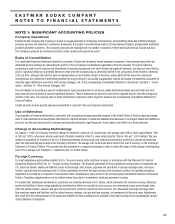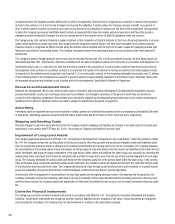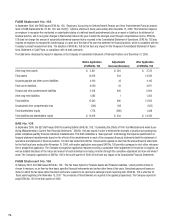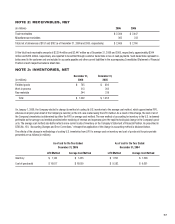Kodak 2006 Annual Report Download - page 74
Download and view the complete annual report
Please find page 74 of the 2006 Kodak annual report below. You can navigate through the pages in the report by either clicking on the pages listed below, or by using the keyword search tool below to find specific information within the annual report.
c o n t i n u e d
NOTE 1: SIGNIFICANT ACCOUNTING POLICIES
Company Operations
Eastman Kodak Company (the Company or Kodak) is engaged primarily in developing, manufacturing, and marketing digital and traditional imaging
products, services and solutions to consumers, businesses, the graphic communications market, the entertainment industry, professionals, healthcare
providers and other customers. The Company’s products are manufactured in a number of countries in North and South America, Europe and Asia.
The Company’s products are marketed and sold in many countries throughout the world.
Basis of Consolidation
The consolidated financial statements include the accounts of Kodak and its majority owned subsidiary companies. Intercompany transactions are
eliminated and net earnings are reduced by the portion of the net earnings of subsidiaries applicable to minority interests. The equity method of
accounting is used for joint ventures and investments in associated companies over which Kodak has significant influence, but does not have effective
control. Significant influence is generally deemed to exist when the Company has an ownership interest in the voting stock of the investee of between
20% and 50%, although other factors, such as representation on the investee’s Board of Directors, voting rights and the impact of commercial
arrangements, are considered in determining whether the equity method of accounting is appropriate. Income and losses of investments accounted for
using the equity method are reported in other income (charges), net, in the accompanying Consolidated Statement of Operations. See Note 7, “Invest-
ments,” and Note 14, “Other Income (Charges), Net.”
The cost method of accounting is used for investments in equity securities that do not have a readily determined market value and when the Com-
pany does not have the ability to exercise significant influence. These investments are carried at cost and are adjusted only for other-than-temporary
declines in fair value. The carrying value of these investments is reported in other long-term assets in the accompanying Consolidated Statement of
Financial Position.
Certain amounts for prior periods have been reclassified to conform to the current period classification.
Use of Estimates
The preparation of financial statements in conformity with accounting principles generally accepted in the United States of America requires manage-
ment to make estimates and assumptions that affect the reported amounts of assets and liabilities and disclosure of contingent assets and liabilities at
year end, and the reported amounts of revenues and expenses during the reporting period. Actual results could differ from those estimates.
Change in Accounting Methodology
On January 1, 2006, the Company elected to change its method of costing its U.S. inventories to the average cost method, which approximates “first-
in, first out” (FIFO), whereas in all prior years most of Kodak’s inventory in the U.S. was costed using the “last-in, first-out” (LIFO) method. The new
method of accounting for inventory in the U.S. is deemed preferable as the average cost method provides better matching of revenue and expenses
given the rapid technological change in the Company’s products. The average cost method also better reflects the cost of inventory on the Company’s
Statement of Financial Position. Prior periods have been restated for comparative purposes in order to reflect the impact of this change in methodology
from LIFO to average cost. See Note 3, “Inventories, Net” for further details.
Foreign Currency
For most subsidiaries and branches outside the U.S., the local currency is the functional currency. In accordance with the Statement of Financial
Accounting Standards (SFAS) No. 52, “Foreign Currency Translation,” the financial statements of these subsidiaries and branches are translated into
U.S. dollars as follows: assets and liabilities at year-end exchange rates; income, expenses and cash flows at average exchange rates; and share-
holders’ equity at historical exchange rates. For those subsidiaries for which the local currency is the functional currency, the resulting translation
adjustment is recorded as a component of accumulated other comprehensive (loss) income in the accompanying Consolidated Statement of Financial
Position. Translation adjustments are not tax-effected since they relate to investments, which are permanent in nature.
For certain other subsidiaries and branches, operations are conducted primarily in U.S. dollars, which is therefore the functional currency. Monetary
assets and liabilities of these foreign subsidiaries and branches, which are recorded in local currency, are remeasured at year-end exchange rates,
while the related revenue, expense, and gain and loss accounts, which are recorded in local currency, are remeasured at average exchange rates.
Non-monetary assets and liabilities, and the related revenue, expense, and gain and loss accounts, are remeasured at historical rates. Adjustments
that result from the remeasurement of the assets and liabilities of these subsidiaries are included in net (loss) earnings in the accompanying Consoli-
dated Statement of Operations.


